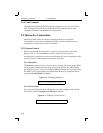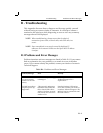
Using the MSS Emulating a Direct Serial Connection
5 - 11
5.3 Emulating a Direct Serial Connection
Two MSS serial servers can be connected to emulate a direct serial connection
on a LAN. Servers connected in this way can pass data only. They will not be
able to pass status signals (DSR, DTS, CTS/RTS, etc.) or preserve timing
between characters. The basic network conÞguration for this virtual serial
line is shown in Figure 5-14.
Figure 5-14: Back-to-back MSS Connection
Assuming the MSS serial port parameters have been conÞgured properly,
they would be conÞgured as follows:
mss_a
Local>> CHANGE DEDICATED TCP
192.168.5.10:3001T
Local>> CHANGE AUTOSTART ENABLED
mss_b
Local>> CHANGE ACCESS REMOTE
Local>> CHANGE DEDICATED NONE
Local>> CHANGE AUTOSTART DISABLED
NOTE: If the two Servers are on different IP subnets, the default gateway
on each unit will have to be configured with the Change Gateway
command (see page 4-10).
The above commands create a raw (8-bit clean) TCP connection between the
serial ports of the two Servers once the units have been power-cycled. The
commands for mss_a ensure that it will automatically connect to mss_b each
time it is booted. Similarly, the commands for mss_b ensure that it is always
available to accept connections from mss_a.
When the UDP protocol is used, there is no connection. Each MSS must be
told explicitly which hosts it is allowed to accept packets from. Broadcast or
multicast IP addresses can be speciÞed to allow an MSS to send packets to all
hosts on a subnet.
Serial Device
Serial Device
mss_a mss_b
Ethernet
192.168.5.2 192.168.5.10


















